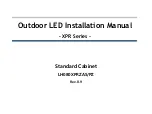
II – 1 Installation Set
u
p
Error Compensation
The distance a cutting tool travels, measured by an encoder, can in
certain cases, differ from the actual tool travel. This error can occur
due to ball screw pitch error or deflection and tilting of axes. This error
can either be linear, or non-linear. These errors can be determined with
a reference measurement system, ex. gauge blocks, laser, etc. From
an analysis of the error, it can be determined which form of
compensation is required, linear, or non-linear error.
The VUE provides the opportunity to compensate for these errors, and
each axis can be programmed separately with the appropriate
compensation.
Linear Error Compensation
Linear error compensation can be applied, if the results of the
comparison with a reference standard show a linear deviation over the
whole measuring length. In this case the error can be compensated by
the calculation of a single correction factor.
To calculate the linear error compensation use this formula:
Correction factor
LEC = (S – M) x 10
6
ppm
with
Example:
If the length of the standard used is 500 mm, and the measured length
along the X-axis is 499.95, then the LEC for the X-axis is 100 parts per
million (ppm).
LEC = (500 – 499.95) x 10
6
ppm = 100 ppm
(rounded to the nearest
whole number).
U
Once determined, the encoder’s error information is entered
directly. Press the TYPE soft key to select LINEAR compensation.
U
Enter the compensation factor in parts per million (ppm) and press
the ENTER key.
Error compensation is only available when using linear
encoders.
S
measured length with reference standard
M
measured length with device at axis
Summary of Contents for VUE
Page 2: ......
Page 6: ...vi Readout Parameter Access Code ...
Page 8: ...viii VUE Fonts ...
Page 10: ...x ...
Page 14: ...xiv ...
Page 54: ...40 II 3 Dimensions ...
Page 57: ......













































